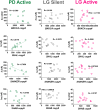Distinct Strategies Regulate Correlated Ion Channel mRNAs and Ionic Currents in Continually versus Episodically Active Neurons
- PMID: 39496483
- PMCID: PMC11574698
- DOI: 10.1523/ENEURO.0320-24.2024
Distinct Strategies Regulate Correlated Ion Channel mRNAs and Ionic Currents in Continually versus Episodically Active Neurons
Abstract
Relationships among membrane currents allow central pattern generator (CPG) neurons to reliably drive motor programs. We hypothesize that continually active CPG neurons utilize activity-dependent feedback to correlate expression of ion channel genes to balance essential membrane currents. However, episodically activated neurons experience absences of activity-dependent feedback and, thus, presumably employ other strategies to coregulate the balance of ionic currents necessary to generate appropriate output after periods of quiescence. To investigate this, we compared continually active pyloric dilator (PD) neurons with episodically active lateral gastric (LG) CPG neurons of the stomatogastric ganglion (STG) in male Cancer borealis crabs. After experimentally activating LG for 8 h, we measured three potassium currents and abundances of their corresponding channel mRNAs. We found that ionic current relationships were correlated in LG's silent state, but ion channel mRNA relationships were correlated in the active state. In continuously active PD neurons, ion channel mRNAs and ionic currents are simultaneously correlated. Therefore, two distinct relationships exist between channel mRNA abundance and the ionic current encoded in these cells: in PD, a direct correlation exists between Shal channel mRNA levels and the A-type potassium current it carries. Conversely, such channel mRNA-current relationships are not detected and appear to be temporally uncoupled in LG neurons. Our results suggest that ongoing feedback maintains membrane current and channel mRNA relationships in continually active PD neurons, while in LG neurons, episodic activity serves to establish channel mRNA relationships necessary to produce the ionic current profile necessary for the next bout of activity.
Keywords: central pattern generator; stomatogastric.
Copyright © 2024 Viteri et al.
Conflict of interest statement
The authors declare no competing financial interests.
Figures






References
MeSH terms
Substances
LinkOut - more resources
Full Text Sources
